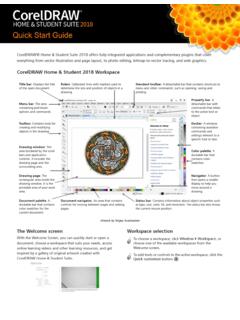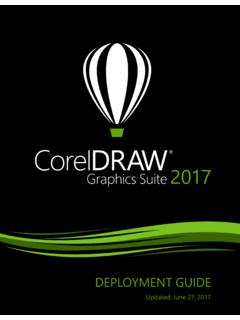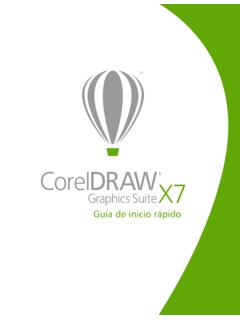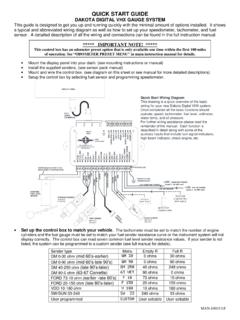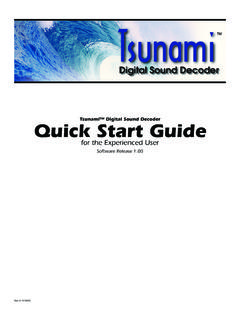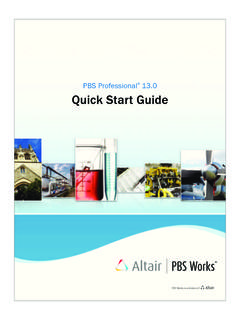Transcription of CorelDRAW Graphics Suite 2018 Quick Start Guide
1 CorelDRAW Graphics Suite 2018 offers fully-integrated applications and complementary plugins that cover everything from vector illustration and page layout, to photo editing, bitmap-to-vector tracing, and web Graphics . CorelDRAW 2018 WorkspaceThe Welcome screenWith the Welcome Screen, you can quickly Start or open a document, choose a workspace that suits your needs, access online learning videos and other learning resources, and get inspired by a gallery of original artwork created with CorelDRAW Graphics selectionThe collection of specialized workspaces are designed to help you increase your productivity by making more accessible the tools that you use most often in specific workflows or workspaces include Default, Touch, Lite, X6 Inspired, Illustration, Page Layout, and Adobe Illustrator.
2 To choose a workspace, click Window Workspace, or choose one of the available workspaces from the Welcome add tools or controls to the active workspace, click the Quick customize button .Title bar: Displays the title of the open : Calibrated lines with markers used to determine the size and position of objects in a toolbar: A detachable bar that contains shortcuts to menu and other commands, such as opening, saving and bar: The area containing pull-down options and bar: A detachable bar with commands that relate to the active tool or o l b o x: Contains tools for creating and modifying objects in the : A window containing available commands and settings relevant to a specific tool or window: The area bordered by the scroll bars and application controls.
3 It includes the drawing page and the surrounding palette: A dockable bar that contains color page: The rectangular area inside the drawing window. It is the printable area of your work : A button that opens a smaller display to help you move around a palette: A dockable bar that contains color swatches for the current navigator: An area that contains controls for moving between pages and adding bar: Contains information about object properties such as type, size, color, fill, and resolution. The status bar also shows the current mouse 2018 toolboxMany of the tools in the CorelDRAW toolbox are organized in flyouts. To access such tools, click the small arrow in the lower-right corner of a button. The illustration below shows the toolbox and flyouts available in the Default workspace, and can help you find tools easily.
4 If you still don t see the tool you are looking for, click the Quick customize button at the bottom of the toolbox. With the help of the Quick customize button, you can also hide tools you don t use m p l a t e sYou can easily Start a new project from a template. You can browse, preview, or search for templates by name, category, keywords, or designer linesThe drawing tools from the Curve flyout let you draw curved and straight lines, and lines containing both curved and straight segments. The line segments are connected by nodes, which are depicted as small Freehand and Polyline tools let you draw freehand lines as if you were sketching on a LiveSketch tool offers the simplicity and speed of freehand sketching combined with intelligent stroke adjustment and vector drawing.
5 As you sketch, CorelDRAW analyses your strokes, adjusts them, and converts them into B zier curves. The B zier and Pen tools let you draw lines one segment at a time by placing each node with precision and controlling the shape of each curved B-spline tool lets you create smooth curves with fewer nodes than curves drawn by using freehand paths. Drawing shapesCorelDRAW offers a wide variety of tools for drawing dragging diagonally with the Rectangle tool , you can draw a rectangle or a square (when holding down Ctrl). The 3-point rectangle tool lets you quickly draw rectangles at an can draw an ellipse by dragging diagonally with the Ellipse tool . Hold down Ctrl to constrain the shape to a circle. The 3-point ellipse tool lets you quickly draw an ellipse at an draw an arc or a pie shape, you can click the Arc or Pie button on the property bar and then shapesYou can use the tools on the Object flyout to draw polygons, grids, spirals, and two types of stars: perfect and complex.
6 Use the property bar to change the number of polygon sides, star points, grid columns, or spiral shapesWith the tools on the Object flyout, you can also draw basic shapes, arrows, flowchart shapes, banners, and callout shapes. Select a preset shape on the property bar, and drag the diamond-shaped handle (glyph) to modify the appearance of some drawingCorelDRAW lets you create symmetrical objects and designs in real time. You can include both vector and bitmap objects in your symmetrical c r e a t e a symmetrical design, select or draw a curve or a shape, right-click it, and click Create New Symmetry. Add more objects, and edit the objects as needed. To add more symmetry lines, type a number in the Mirror lines box on the property bar.
7 Click Object Symmetry Finish Editing x tThere are two types of text you can add to drawings: paragraph text and artistic text. You can also import existing text from an external file or paste text from the textParagraph text can be used for larger bodies of text that have greater formatting requirements. Before you add paragraph text, you must drag with the Te x t tool to create a text insert placeholder text, right-click the text frame, and click Insert Placeholder Text. Placeholder text makes it easier to assess the appearance of your document prior to finalizing its textYou can use artistic text for short lines of text to which you can apply a wide range of effects, such as drop shadows or contours. You can add artistic text to an open or a closed text to a pathTo fit text to a path, select the text, and click Te x t Fit Text to Path.
8 Move the pointer over a path and use the dynamic preview to position the text. Click to attach the text to the type text on a path, click the Te x t tool, and point to a path. When the pointer changes to a Fit to Path pointer, click to add fontsWith the Font list box in CorelDRAW and Corel PHOTO-PAINT, you can view, filter, and find fonts easily. Filter fonts based on weight, width, supported scripts, and more; use keywords to search for fonts; and download font packs with OpenType featuresOpenType features let you choose alternative appearances for individual characters (glyphs), provided that the font and selected characters support OpenType features. OpenType features include fractions, ligatures, ordinals, ornaments, small caps, swashes, and more.
9 OpenType fonts are based on Unicode, which makes them ideal for cross-platform and multi-language design work. In addition, CorelDRAW will suggest eligible OpenType features that you can apply to your Character dockerThe Insert Character docker (Te x t Insert Character) presents all characters, symbols, and glyphs associated with a selected font, making it easier to find and insert characters into your layoutThe Page property bar lets you adjust page settings, such as page size, dimensions, orientation (landscape or portrait), units of measure, nudge distance, and duplicate access the Page property bar, click the Pick tool , and click a blank space in the drawing a page tab on the document navigator to open a context menu that lets you rename, delete, or duplicate the current page or insert new navigate the pages in a document, use the document navigator in the lower left of the application insert page numbers, click Layout Page Number Settings, and choose the settings you layout toolsYou can display rulers, grids, and guidelines to help you organize objects and place them exactly where you view or hide grids, guidelines, and rulers, click the View menu, and choose the items you want to content is placed on a layer.
10 Content that applies to a specific page is placed on a local layer. Content that applies to all pages in a document can be placed on a global layer called a master layer. Master layers are stored on a virtual page called the Master layersWith a choice of odd, even, and all-page master layers, it is easy to create page-specific designs for multi-page documents, such as 16- or 32-page brochures. For example, you might want a different header or footer design to appear on even-numbered pages and on odd-numbered scaleYou can choose a preset or custom drawing scale so that distances in a drawing are proportionate to real-world distances. For example, you can specify that 1 inch in the drawing corresponds to 1 meter in the physical set the drawing scale, double-click a ruler to display the Options dialog box.

